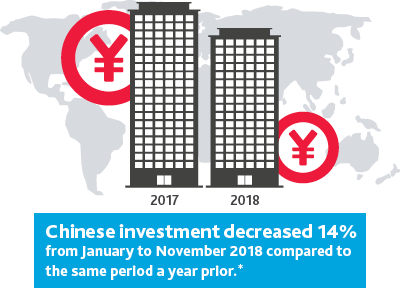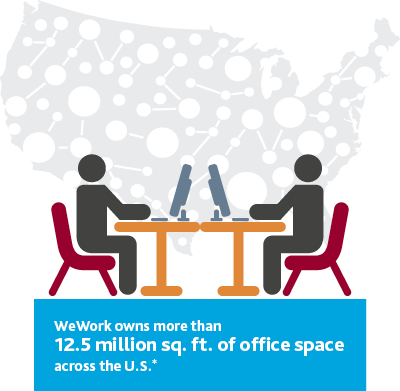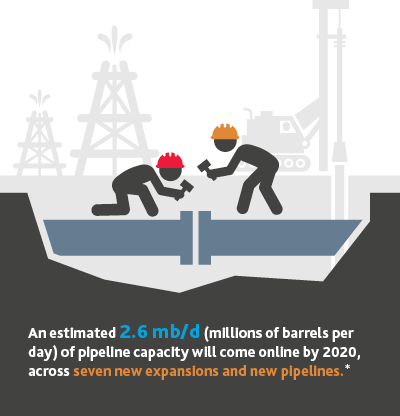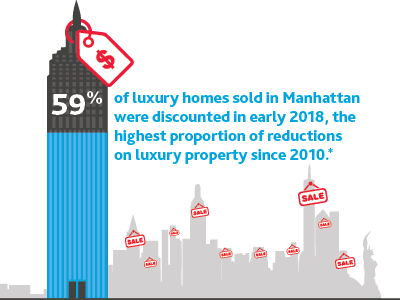Tax Reform, Trade Turbulence and More: 5 Real Estate & Construction Predictions for 2019
Marked by turbulent trade conditions, a shifting retail landscape, continued fallout over tax reform and the accelerated growth of coworking companies, 2018 has been an eventful year for the real estate and construction industries.
As we enter 2019, a variety of forces are at play. The IRS will continue to release additional guidance on provisions introduced via tax reform, the future of U.S. trade policy is uncertain and interest rates will likely rise again.
As the new year unfolds, we’ve outlined our top five predictions for 2019.
PREDICTION #1
Turbulent trade: Trade tensions will accelerate Chinese investors’ retreat from U.S. commercial real estate.

Even before the U.S.-China relationship entered rocky waters in 2018, Chinese investment in U.S. real estate was already declining.
The heated tariff disputes in 2018 hastened Chinese investors’ divestment from the U.S. real estate market. In mid‑2018, China became a net seller of U.S. commercial property for the first time in a decade. While tariff de‑escalation could occur in 2019, Chinese investment is unlikely to
return to the sector.
Despite decreased activity from a key foreign investor, U.S. developers shouldn’t fret. Plenty of investment capital—or “dry powder”—is still available for new projects, and U.S. real estate remains an attractive investment prospect for foreign investors at large. The pullback of Chinese investors should not hamper new projects from getting off the ground in 2019.
PREDICTION #2
Office and retail tenants are already pushing for shorter lease terms, and a preference for flexible leasing will spread to other property types in 2019.

The rapid growth of WeWork and other coworking providers has made short-term and flexible office leases more widespread.
As major corporations follow startups and freelancers and embrace shorter leases, traditional landlords will expand their own flexible offerings to remain competitive.
Retailers are also pursuing shorter leases in response to the high rate of store closures, bankruptcies and liquidations. Increased flexibility with brick-andmortar locations affords retailers increased nimbleness and helps minimize the risk of defaulting on a lengthy lease. Amid higher tenant turnover, many retail landlords are in turn offering shorter-term leases to new and experience-based tenants as a strategy to keep properties occupied.
The lease accounting standard, which goes into effect for publicly traded companies in 2019, provides an added incentive for tenants to demand shorter leases. Companies will be required to record lease obligations in their balance sheets. The uncertainty as to how the large liabilities will be viewed by the investment community and lenders is of concern to both landlords and tenants.
In 2019, more tenants will seek to restructure their leases or sign new leases with shorter terms. While tenants favor flexibility, the shift introduces uncertainty for landlords. Lenders may be less willing to provide longterm financing for shorter leases on commercial properties, which would complicate budgeting and planning for owners of commercial properties.
PREDICTION #3
Demand for new infrastructure projects will increase, but construction labor woes continue.

Good news for contractors: Demand for new infrastructure will likely receive bipartisan support in 2019.
If a bill to fund new projects passes, there will be no shortage of new projects breaking ground—U.S. bridges, roads and tunnels across the nation are in dire need of repair.
Additionally, there is high demand for new pipeline infrastructure in the energy sector. While shale production in the Permian Basin has boomed, a lack of midstream infrastructure has caused bottlenecks and an urgent need for new pipelines.
Despite the high demand for new projects, we anticipate that the construction sector’s chronic labor problems will continue—more specifically, the gap between demand and the available supply of skilled workers to support those projects. To mitigate these gaps, companies should look to technological solutions to augment their operations.
PREDICTION #4
Opportunity zones in urban areas will attract the most investment.

Opportunity zones will be a major focus area for developers next year, and the majority of investment will likely be within major urban areas, rather than secondary or tertiary cities.
Opportunity zones were created as part of the federal tax reform legislation in 2017 to spur economic stimulus in eligible low-income areas by offering tax benefits to investors. As more guidance is published about the specific tax incentives, developers and investors—including large corporations, REITs, and both retail and high net worth investors—are eager to enter the fray.
While not all opportunity zones are in urban areas, large metropolises are likely to receive the lion’s share of developer interest in 2019. On the whole, developers are more highly concentrated in urban areas than rural ones and are likely to invest in areas where they have intimate market knowledge or already have an established footprint. As investors scope out opportunity zone projects in 2019, they should assess potential investments with the same level of due diligence they would use in any other deal.
PREDICTION #5
A continued supply glut of Manhattan high-end condominiums will lead to distressed asset sales and foreclosures in 2019.

Manhattan’s luxury real estate market is in the midst of a three‑year rough patch.
In the third quarter of 2018, sales volume was down by more than 11 percent from the prior year, a Douglas Elliman report found. On average, properties that are sold in this climate go for lower prices.
The outlook for luxury real estate is worrisome. The inventory of luxury apartments for sale hit its highest level in seven years in mid-2018. In spite of the oversupply, additional new construction is expected to come
online. The market for high-end condominiums has a diminishing set of buyers, as stricter anti-money laundering regulations discourage foreign buyers, and U.S. buyers become more price-conscious.
With no end in sight to the supply glut and few buyers vying for properties, sellers could reach a breaking point in 2019. In 2019, distressed asset sales of high-end condominiums and foreclosures on the properties will increase.
SHARE